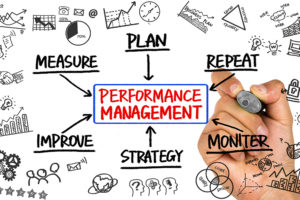Table of Contents
- 1) Regularity
- 2) Objectives and goals focus
- 3) Development & training
- 4) Two-way conversations
- 5) Balanced feedback
- 6) Documentation and data
- 7) Establish expectations and plan follow-up
- Discover how Netchex can improve your company’s employee review process:
- Industry news & tips sent straight to your inbox!
Share
Your company’s employee review process says a lot about your company culture. Reviews aren’t just a designated time to tell workers how to improve their performance. Rather, the employee review process has the potential to improve employee engagement and overall company culture.
It is easy for the employee review process to veer off-course:
- Do your managers really listen to employees?
- Does your review process use a rigidly impersonal structure?
- Do evaluations focus only on the negative?
- Are reviews detached from everyday responsibilities?
- Do reviews lack data across teams or over time?
With HR technology, it is easy to get your review process started from scratch or back on the right track. Be sure to include these seven elements to make the most of your company’s employee review process.
1) Regularity
Your employee review process needs a regular schedule and format. Without consistency, reviews feel arbitrary and subjective.
Routine one-on-one meetings with a manager will be less detailed than quarterly reviews or annual assessments, but the structure and subject matter should be familiar. Consistent reviews should connect everything together, as issues and achievements from month to month are revisited at the annual overview.
Whether you use the hiring anniversary or another marker for annual employee reviews, the year’s biggest review shouldn’t focus on cataloging details you’ve already covered in past meetings. Instead, consider the big picture trends and remember to look forward by setting realistic goals for improvement in the future.
2) Objectives and goals focus
While looking back over recent performance, the review process should also emphasize planning for the future. Were last month’s productivity goals achieved? Either way, there will always be takeaways for next month.
Personal goals should correspond to the larger goals for the team and whole company. The review meeting is a good time to establish new goals for the weeks ahead. Make objectives and goals an interactive conversation, not a top-down imposition.
Be careful not to give a false impression about potential incentives for achieving goals. Managers may be accused of “moving the goalposts” if employees expect a particular reward for goals and they keep getting new goals instead.
Objectives and goals provide a framework to talk about productivity on a personal level. Other alternatives like optional training can provide pathways to incentives like career growth.
3) Development & training
Upskilling is key to retention, and a Learning Management System (LMS) can close skill gaps, enable cross training, and develop future managers. Your LMS can provide cross training programs and quiz trainees on their comprehension.
Include ongoing development and training in your employee review process, and make sure everyone is on the same page. Ambitious and career-minded workers will appreciate the chance to develop new skills and qualifications.
Occasionally, managers may be able to arrange ways for workers to put new skills to use. When special projects aren’t available, you may still be able to send workers to different departments for a limited time.
4) Two-way conversations
Even a 360 review is incomplete without hearing the employee’s perspective. While you may have detailed metrics about productivity, it’s still good to invite the employee to share their perspective. Try to approach employee reviews as a dialogue in both directions, rather than a lecture from boss to employee.
Whenever your review provides a load of feedback or analysis, keep the meeting open for questions and discussion. Avoid yes or no questions like “Does that make sense?” Instead, it can be helpful to ask for specifics, like “What are three ways we can improve these numbers for next quarter?”
5) Balanced feedback
When you have negative feedback to convey, a “compliment sandwich” makes it easier for the listener to hear the criticism. An employee review that’s exclusively negative will feel like an attack, and the worker may have a hard time learning from the experience.
If you deliver a mix of good and bad feedback in reviews, then workers understand it’s not all negatively biased against them. The positive things are also worth acknowledging and celebrating for their own sake.
Multiple perspectives give a more rounded view. Use 360 reviews to get opinions from the teammates, coworkers, and subordinates of the employee. Opinions from colleagues should be anonymous and filtered in a way to avoid creating conflict or tension. Positive kudos can be attributed, whether they come from clients or other workers.
6) Documentation and data
HR needs data integration software for faster reporting and employee reviews. Automatic documentation makes it easier to collect substantive reports. The more you know about each individual employee’s productivity, the fewer gaps you need to fill with subjective surveys. Focusing on concrete data also ensures a measure of objectivity.
Depending on your industry and the worker’s department, different metrics could be used to track productivity. Timekeeping software quickly flags issues like tardiness and absenteeism. Your LMS should say how many training programs have been completed, including quiz scores. Whatever you choose to include, some metrics will naturally carry different weight.
7) Establish expectations and plan follow-up
Use a conversational approach to define goals for the worker’s performance going forward. Some goals are negotiable and arbitrary, and modest goals can be more appropriate in periods of adversity. As your reviews become more goal-oriented, they will naturally look to the future. Any recent problems are opportunities for improvement.
Your review meetings shouldn’t be the only time for follow-up and communication. Especially if there’s a plan to overcome some personal hurdle or experiment with something new, then it’s totally reasonable to check-in more frequently on that progress. If meaningful change is expected in the time between evaluations, then you shouldn’t wait until the next official evaluation to offer support.
Discover how Netchex can improve your company’s employee review process:
Industry news & tips sent straight to your inbox!
Enter your email below to subscribe to industry news, product updates, and tips.
Related articles

Six HR Metrics to Quantify and Track Manager Effectiveness

Understanding 9-Box Reporting for Performance Management

Tips for Setting, Measuring, and Tracking Employee Goals

